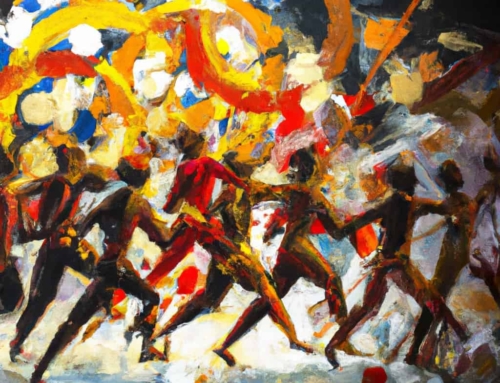Zero to Hero: How to Start Running if You’ve Never Run Before
Running.
It’s an activity everyone wants to do these days.
Some people want to run for weight loss. Others want to cross an item off their bucket list, like run a 5K or finish a marathon.
But how do you start running if you’ve never run before? How do you run a mile (let alone finish a race) if you’re not athletic?

These are valid questions and concerns that I empathize with.
With the exception of my high school gym class and mandatory PE course in college, I had never run a day in my life.
Fast-forward a few years. Now, I’m a running addict, having raced at least 50 certified course 5Ks, a dozen half marathons and countless 15Ks in-between.
All of that to say: if I can do it, so can you.
So how do you become a “runner?”
The Truth About Running for Beginners
Let me let you in on a little secret: You’re already a runner.
That’s right. You. You were born a runner.
Running is absolutely the most natural form of exercise.
 “But I’ve never run in my life! I can’t even run a mile. I’m slow!” you might protest.
“But I’ve never run in my life! I can’t even run a mile. I’m slow!” you might protest.
It doesn’t matter. Remember the old running adage: “A 12-minute mile is just as far as a 6-minute mile.”
Slogans don’t get much truer than this. No matter how “slow” you are, you are still running faster than everybody on the couch.
And this leads me to the greatest running secret for beginners: start slowly.
If you can’t hold a conversation with someone while you’re running, then you are running too fast.
So I repeat: Run. Slowly.
I can’t tell you how many times I’ve seen new runners take off sprinting as though they’re in the Olympics or something.
This is a guaranteed way to burn out.
Sure, you might feel great at first, but then your legs feel as heavy as logs. Lactic acid starts coursing through your body. You can’t catch your breath. Was running always this hard?
If you want to get good at running, then start slowly.
 Go at an easy pace that allows you to maintain a conversation. If you have no one to talk to, then try reciting the Pledge of Allegiance. If you run out of breath, then you’re probably running too fast. Pull back a few notches, then try again.
Go at an easy pace that allows you to maintain a conversation. If you have no one to talk to, then try reciting the Pledge of Allegiance. If you run out of breath, then you’re probably running too fast. Pull back a few notches, then try again.
Running slowly is the greatest secret to running stronger and faster.
In the running world, we call this your “easy pace.”
This so-called “easy pace” is going to be different for everyone. Generally, the more fit you are, the faster your easy pace will be.
For example, someone who has experience in other sports, like swimming or basketball, might have a faster easy pace than someone who never participated in sports.
Your easy pace if unique to you. No matter what, do not compare yourself to other runners (at least, not yet).
You focus on running your run.
Focus on your pace – is it comfortable enough? Focus on your form – are you running with a tall, straight back without slouching? Focus on your stride – are you staying light on the balls of your feet? Focus on staying relaxed – are you tensing unnecessarily anywhere in your body?
If you embrace this secret, you’ll find that running isn’t as scary as you think.
In fact, running is quite easy once you build some baseline fitness.
How to Run a Mile for the First Time
A lot of training plans make it sound like you can become a runner in as little as 8 to 12 weeks.
While you’ll definitely be better than you are today, it’s important to set realistic expectations.
Don’t expect super-impressive mileage or super-fast times your first month out. Take it slow and allow your body to improve at it’s own pace.
Brand new runners who increase mileage too quickly or push their pace too hard put themselves at risk of serious injury. The best way to avoid injury is to listen to your body.
Here’s how to safely run your first mile if you’ve never run before:
- 1. Begin by walking.
That’s right: walking. If you’re running for the very first time, then your body isn’t going to be conditioned to handle a mile.
 Running impacts your joints. It takes endurance. Your calves need basic strength to be able to propel your body forward.
Running impacts your joints. It takes endurance. Your calves need basic strength to be able to propel your body forward.
Walking consistently is the “gateway exercise” to running. Challenge yourself to walk consistently for 30 minutes up to 5 times a week.
When it feels too easy, push yourself.
Walk briskly, with purpose. Imagine you’re in the concrete jungle of New York City and are walking to a meeting you’re 5 minutes late for. But you can’t quite run because you don’t want to drench your brand new suit or dress in sweat.
Your walks should have this same level of intensity.
- 2. Transition to a walk / run program.
Once walking feels easy, it’s time to begin the walk / run method.
 This is perfect for beginners who are brand new to running. The walk / run method is a form of interval training that will help you burn more calories and help you build the endurance necessary to run a mile.
This is perfect for beginners who are brand new to running. The walk / run method is a form of interval training that will help you burn more calories and help you build the endurance necessary to run a mile.
The continuous use of muscle results in fatigue. This is why so many people think running is so hard. Their body isn’t used to the constant energy output and resulting fatigue.
If you’ve ever said, “I hate running,” that’s probably why.
Fortunately, the walk / run method gives you “active recovery” breaks that allow you to run longer and stronger.
Try this 8 week schedule:
- Week One: Walk for 3 minutes, run for 1 minute.
- Week Two: Walk for 2 minutes, run for 1 minute.
- Week Three: Walk for 2 minutes, run for 2 minutes.
- Week Four: Run for 4 minutes, walk for 1 minute.
- Week Five: Run for 6 minutes, walk for 1 minute.
- Week Six: Run for 7 minutes, walk for 1 minute.
- Week Seven: Run for 8 minutes, walk for 1 minute.
- Week Eight: Run for 9 minutes, walk for 1 minute.
Be sure to run / walk at least four to five times per week. By sticking to this schedule, your endurance and strength should begin to skyrocket. You might even find that your lungs are stronger than ever.
You’ll learn how to mentally push yourself. You’ll begin to appreciate and celebrate the small victories on the road to running success.
- 3. Decrease the walk interval in-between runs.
You’re so close to being able to run a mile. Don’t stop now!
Once you’ve mastered the walk / run routine, it’s time to begin eliminating those walking intervals.
Instead of walking for 1 minute, see if you can walk for 45 seconds. Once that feels comfortable, aim for 30 seconds. Then 15 seconds.
Now… congratulations! You can comfortably run a mile without stopping.
- 4. It’s time to add some speed.
The great thing about running is that there’s always room for improvement.
You can always run faster and longer. You can always work on your form. You can master the art of breathing while running. There are so many different aspects to consider.
 But most people at this point of their running journey are primarily concerned about speed.
But most people at this point of their running journey are primarily concerned about speed.
Once you can run comfortably and consistently, you probably are going to want to learn how to run fast.
While running fast is a topic worthy of its own post, let me let you in on just one of the secrets to speed: leg-turnover.
The faster leg-turnover you have, the faster you’ll move.
The best way to develop healthy leg turnover is to do 3 or 4 strides after every run.
Strides are short sprints (80-90 percent of maximum effort) for about 100 meters. For most people, this is a 15 second sprint.
Strides let you focus on your form, practice speed work, and loosen up your legs after an easy (but long) running session.

Be Patient and Stick to a Plan
Many of the incredible, positive changes are happening inside your body. You’re heart becomes stronger, your muscles become leaner, your cells become healthier.
In other words, you won’t see all of these changes immediately. The growth and progress you make as a runner won’t always be visible in the mirror or on the scale.
This is where dedication and commitment come into play.
Be patient and keep putting in the time, effort, and mileage.
You don’t have to run a 6-minute mile or finish a dozen marathons to be a “runner.” Simply lace your running shoes and hit the road.
You were born a runner and every step is worth it!










